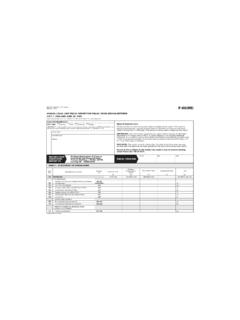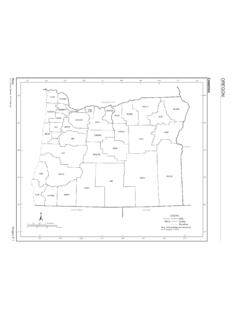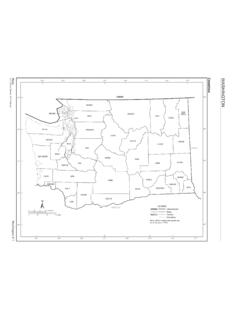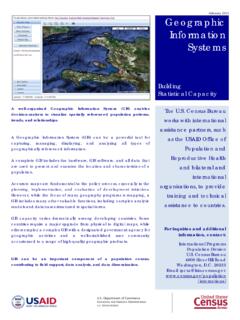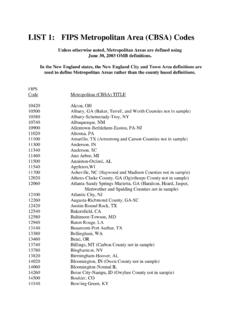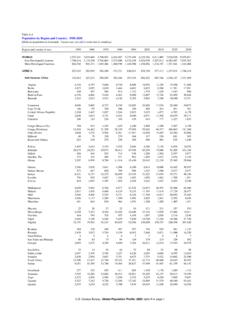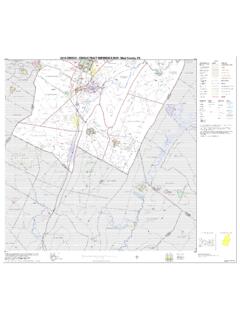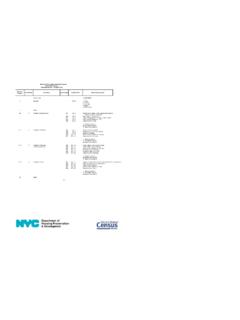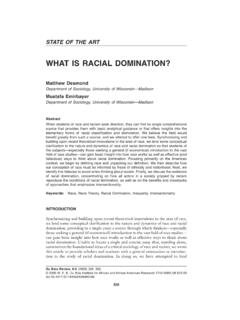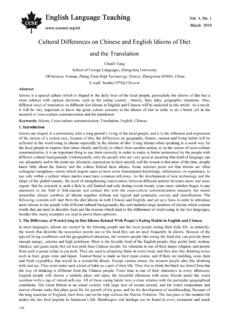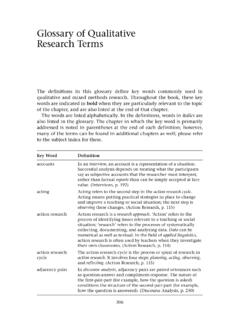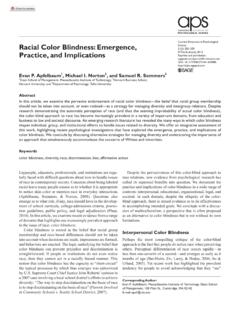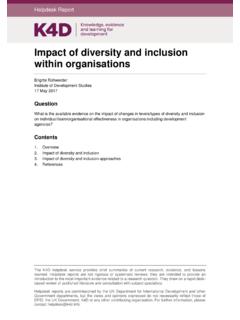Transcription of Methodology for the 2020 Demographic Analysis Estimates
1 Methodology for the 2020 Demographic Analysis Estimates December 15, 2020 Eric B. Jensen, Anthony Knapp, Heather King, David Armstrong, Sandra L. Johnson, Larry Sink, and Esther Miller population Division Census Bureau 2 INTRODUCTION Demographic Analysis (DA) is one of two methods that the Census Bureau will use to estimate coverage in the 2020 Census. The other method is the Post-Enumeration Survey (PES). Coverage error occurs when groups are undercounted or overcounted in the census. The DA program uses current and historical vital records, data on international migration, and Medicare records to produce national Estimates of the population on April 1, 2020 by age, sex, the DA race categories, and Hispanic origin.
2 The results will be compared to the census counts to evaluate net coverage error. For the 2020 DA, we produced three sets of official Estimates . In addition, experimental Estimates are planned to be released at a later time. The official Estimates use many data sources and methods that have been employed to evaluate previous censuses. The experimental Estimates will explore new data and methods. In addition, we produced a range of Estimates (low, middle, and high) for the three sets of official Estimates to account for uncertainty in the data, methods, and assumptions used for the 2020 DA. The 2020 DA Estimates were developed using a basic population accounting approach. The main source of data for the births and deaths is the National Vital Statistics System maintained by the National Center for Health Statistics (NCHS).
3 The foreign-born population for all birth cohorts was estimated primarily using a stock method and data from the American Community Survey (ACS). The Estimates of the population born before 1945 (ages 75 and older) were developed using Medicare This document summarizes the Methodology used to produce the official 2020 DA Estimates . The first section provides a description of the three sets of official Estimates and an overview of the general DA method. Next, we present more detailed information about the methods used to develop the birth, native death, international migration, military, and Medicare Estimates . Finally, we discuss how we evaluated uncertainty in the DA Estimates by producing a low, middle, and high series for each set of official Estimates .
4 Different Sets of Estimates The three official sets of DA Estimates describe the nation s population for April 1, 2020 using different Demographic detail. Table 1 describes the Demographic characteristics and corresponding age cohorts for each set of Estimates . The Black alone/non-Black alone Estimates include information for all ages (0 to 85 and older) by sex. We restrict the race categories to Black alone and non-Black alone because of limitations in race reporting in the historical vital records. To reflect the increasing number of people who identify as more than one race in the census, we also produced Estimates of the Black alone or in combination (AOIC)/non-Black 1 The 2010 DA Estimates used birth records starting in 1935.
5 For 2020, Medicare records were used for the population born between 1935 and 1944 to mitigate issues with birth registration completeness for some of the cohorts born between 1935 and 1944. This change also leveraged improvements to the Medicare method. 3 AOIC population by sex for ages 0 to 85 and older. This is different from the 2010 DA Estimates , where Black AOIC/non-Black AOIC Estimates were only produced for the population aged 0 to 29. Finally, we produced Hispanic/non-Hispanic Estimates by sex for the population aged 0 to 29, or birth cohorts from 1990 to 2020. Hispanic origin was not reported in vital records files by all states until 1990; therefore, these Estimates can only be produced for the cohorts born after 1989.
6 All three official series will be used to calculate net coverage error. The Black alone/non-Black alone and Black AOIC/non-Black AOIC Estimates will also be used as inputs into the PES Estimates of coverage error. The PES operation uses the DA Estimates to adjust for correlation bias between the PES and the census counts. Correlation bias occurs when the same populations that are missed in the census are also missed in the survey (Konicki 2012). DA Method The method used to produce the 2020 DA Estimates can be conceptualized using a Demographic accounting ledger (Table 2). The ledger shows the components, data sources, and methods for each cohort included in the 2020 DA Estimates . The N in the table represents cells that will be populated with an estimate, while the.
7 Represents cells that will not have an estimate. For example, we do not produce Estimates for ages 0 to 74 with the Medicare records. Nor do we produce Estimates of the Armed Forces overseas component for ages 0 to 17 or 65 and older. Thus, these are represented by a . in the ledger. The table also shows how the components are either added or subtracted to estimate the resident population . The accounting ledger provides another way to conceptualize the complex process used to produce the 2020 DA Estimates . Before they can be included in the ledger, the components need to be standardized by age in 2020, a process that we refer to as cohortization. For example, to cohortize the births in 1980, we would subtract 1980 from 2020, which equals 40 and is the age in 2020 of the cohort born in 1980.
8 Births are the easiest component to conceptualize the cohortization process, while other components are more complicated. To cohortize deaths, we need to determine which birth cohort the person was in and then calculate what their age would have been in 2020. For example, if a person died in 2005 at age 25, then we subtract 25 from 2005 to get 1980, and from there we can determine that they would have been age 40 in 2020. The examples above are simplified to illustrate how the components are cohortized. The actual process of cohortization is more complex because births are spread out over each year, and the age of the person on April 1, 2020 will vary depending on when they were born. people born in 1980 could either be 39 or 40 years old on April 1, 2020 and we account for that in our process.
9 For births, we have the date of birth; therefore, we can cohortize their age exactly. For other components, we divide the population in half and subtract 1 from the age in 2020, a process referred to by demographers as age centering. 4 The sections below detail the data and methods used to estimate each of the nine components in the 2020 DA Ledger. After the components have been cohortized and entered into the ledger, the resident population on April 1, 2020 is calculated by adding and subtracting the different components accordingly. Tables 3, 4, and 5 provide the results for each set of Estimates . BIRTHS Births are the foundation of the DA Estimates . For the 2020 DA, we used NCHS birth records from 1945 to 2018 and national birth totals from 2019 through the first quarter of In this section, we present the Methodology used to assign race to births, develop consistent race assignment over time, correct for under-registration in the historical births records, and develop the range of Estimates for births.
10 Assigning Race to Births Birth records do not include race and ethnicity detail for the child, but there is information about the race and ethnicity of the mother and father. There are several approaches that the Census Bureau has used to assign race and Hispanic origin to births using the characteristics of biological parents. T he approaches include (1) the Minority Rule where the race of a non-White parent in mixed -race couples is assigned to the birth; (2) the Mother Rule where the child is assigned the race of the mother; (3) the Father Rule where the child is assigned the race of the father; (4) the Both Parent Rule where a particular race is assigned to the child only when both parents are in that race group.
